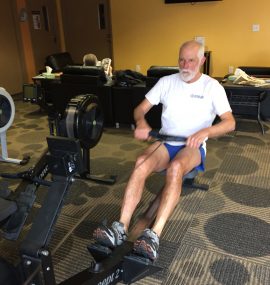Better cardio in less time
Overweight and diabetic people can benefit
One of my previous posts extolled the benefits of interval training (IT). To refresh your memory, IT refers to periods of movement, such as running or stair climbing or rowing, with each movement period followed by a recovery period, such as walking slowly.
IT has experienced a recent surge in academic research. Canadian researchers Jenna Gillen and Martin Gibala distinguish among several types of HIIT. High-intensity interval training (HIIT) involves short, relatively intense but sub-maximal periods of exertion that elevate heart rate to 80% or more of maximum. Brief HIIT training sessions (10 minutes) can produce comparable or better cardiovascular benefits than longer (30 minutes) moderate-intensity interval training sessions. Thus, HIIT is a time-efficient way to improve cardiorespiratory fitness. HIIT is especially valuable for people who feel they don’t have enough time in the day to Keep Moving.
A recent systematic review and meta-analysis showed that a long-term (greater than 12 weeks) program of HIIT improved cardiometabolic risk factors in overweight / obese subjects. Improvements included greater maximal oxygen intake and lower waist circumference, percent body fat, resting heart rate, diastolic blood pressure, and systolic blood pressure. Maximal oxygen intake increased as the length of training increased. Given the relatively short time period required for HIIT compared to traditional training, the former may be an effective way to help overweight and obese persons improve their health and well-being through improved cardiometabolic fitness.
The “high-intensity” part of HIIT might sound daunting to many people who would truly benefit from Keep Moving. Would a relaxed-exertion version of high-intensity interval training (ReHIIT) still provide substantial cardiovascular benefits in a time-efficient way? Researchers in the UK conducted a pilot study of 16 obese or overweight, diabetic middle-aged men to find out. Each subject engaged in 1) 8 weeks of ReHIIT consisting of three low-intensity cycling sessions per week with two full-on sprints for 10-20 seconds each; and 2) 8 weeks of moderate-intensity walking corresponding to 45-55 percent of maximum heart rate with five 30-minute sessions per week. A two-month wash-out period separated the two physical activity regimens. ReHIIT led to significantly greater increase in maximal aerobic capacity than walking (7 versus 1 percent). Both regimens similarly reduced arterial pressure. Neither regimen improved insulin sensitivity. ReHIIT increased aerobic fitness more than moderate-intensity walking, even though REHIT consumed only 30 minutes per week compared to 150 for walking. ReHIIT appears to be a time-efficient alternative to walking for improving aerobic fitness.
I’ve incorporated HIIT into my thrice-weekly workouts at the YMCA. Currently, I spend 5 minutes per workout on a rowing machine with 20 second-periods of high-intensity (but not all-out) effort alternating with 20-second periods of barely rowing. You could do the same.








